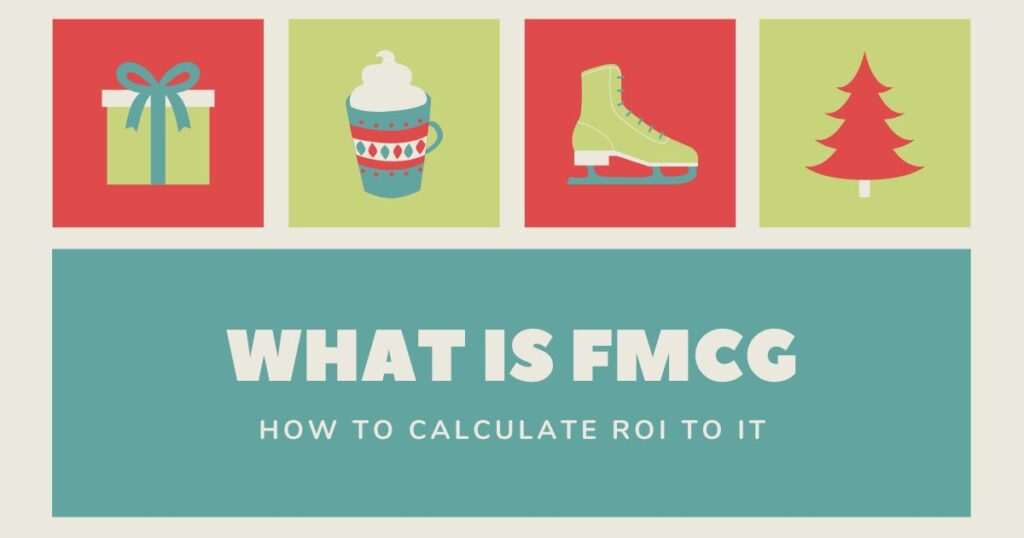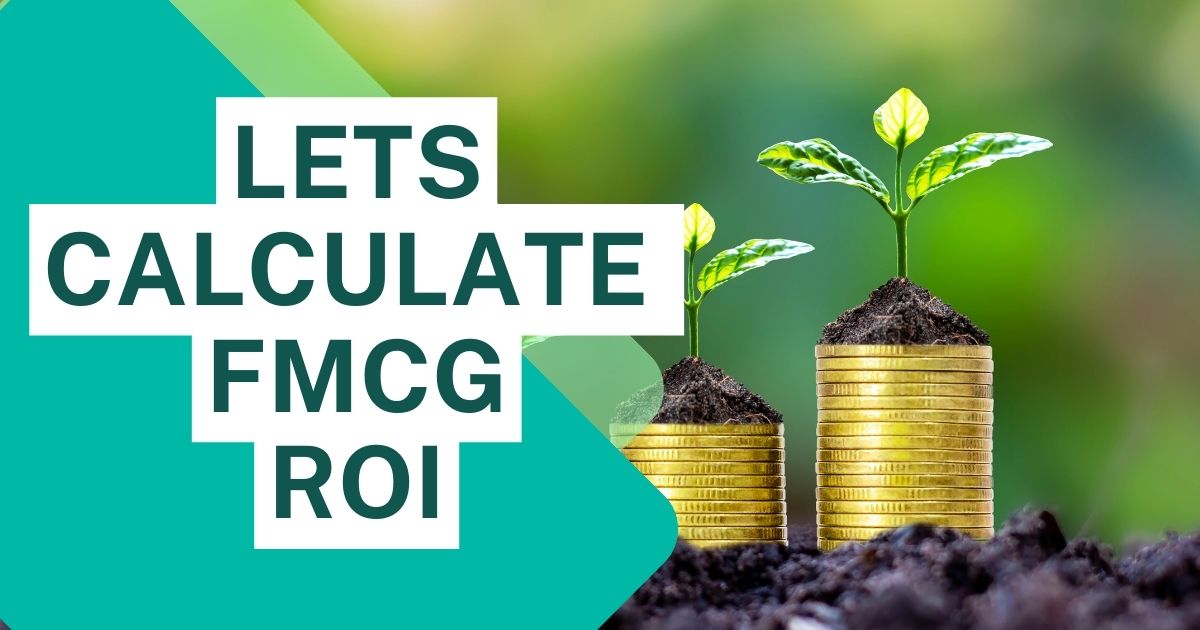Have you ever thought about how FMCG (Fast-Moving Consumer Goods) companies that sell everyday items , like snacks and shampoo , figure out if their products are popular ? They use something called ROI , which stands for Return on Investment. It’s like a report card that shows how well their money is being used.
In this blog you will be understanding what ROI is? How is ROI calculated for fmcg ? why it’s really important for these companies , and how they figure it out. All the explanations about ROI for FMCG in this blog are student friendly in simple words with examples.
roi calculation with example in fmcg
Contents
ROI calculation for FMCG
What is ROI ?
ROI stands for Return on Investment. It’s a method for businesses to see how much profit they are making from their investments. Imagine you invested some money into a project , and got some returns , ROI helps you figure out if that project is making you more money than you invested.
Formula to Calculate ROI
The formula to find ROI is simple :
ROI = NET PROFIT / TOTAL INVESTMENTS X 100
Where ,
NET PROFIT = TOTAL INVESTMENT – EXCESS RETURN
TOTAL INVESTMENTS = AMOUNT INVESTED
For Example : Let’s say you have invested 1,00,000 Rs in creating Instagram ads for a product to sell . By 1,00,000 Rs investment you sold 100 products worth 1,500 Rs each . So , your Return is 1,50,000 Rs . So your net profit is 50,000 Rs.
So , Your ROI will be (50,000 / 1,00,000 ) x 100 = 50 % .

how to calculate roi in fmcg
What is FMCG ?
FMCG means ” Fast Moving Consumer Goods ” . These are goods that sell quickly and at relatively low price .
Examples of FMCG products :
- Food and Beverages : Snacks , drinks , dairy products.
- Household Items : Detergents , cleaning supplies , toiletries.
- Personal Care Products : Toothpaste , soap , shampoo.
- Over-the-Counter Drugs : Pain relievers, cough syrups.
Global FMCG Companies
Procter & Gamble (P&G)
- Tide
- Pantene
- Pampers
Unilever
- Lux
- Knorr
- Dove
Nestlé
- Nescafé
- Maggi
- Nestlé milk
The Coca-Cola Company
- Coca-Cola
- Sprite
- Fanta
PepsiCo
- Pepsi
- Lays
- Doritos
Colgate-Palmolive
- Colgate
- Palmolive
Johnson & Johnson
- Johnson’s Baby
- Neutrogena
Indian FMCG Companies
Hindustan Unilever Limited (HUL)
- Surf Excel
- Lifebuoy
- Fair & Lovely
ITC Limited
- Aashirvaad
- Fiama
- Classmate
Dabur India Limited
- Dabur Chyawanprash
- Dabur Amla
- Dabur Red
Godrej Consumer Products Limited (GCPL)
- Godrej No. 1
- Godrej Expert
- Good Knight
Marico Limited
- Parachute
- Saffola
Amul (Gujarat Cooperative Milk Marketing Federation)
- Amul butter
- Amul milk
- Amul cheese
Britannia Industries Limited
- Good Day
- Marie gold
These goods are in high demand, used rapidly, and bought frequently. Because they have quick turnover and low prices, they are essential in daily consumer life.
LETS KNOW roi calculation with example in fmcg IN FOLLOWING
Why is ROI Important in FMCG?

In the FMCG sector, margins can be thin, and the market is highly competitive. Calculating ROI helps companies understand the effectiveness of their investments, whether in production, marketing, or distribution. It provides insights into how well the resources are being utilized to generate profits.
Apart from ROI, companies look at things like sales growth, market share, and customer happiness. But ROI is often the most important because it directly shows how well investments are doing.
Now, let’s move on to how to calculate ROI in the FMCG sector.
Components of ROI in FMCG
Revenue :
Revenue is the total money earned from selling products.
Cost of Goods Sold (COGS) :
COGS is the cost of manufacturing the products , like materials and labor.
Operating Expenses :
Operating expenses are other costs of running the business , like marketing and rent.
Steps to Calculate ROI in FMCG
- Determine Total Revenue : Calculate the total money from sales.
- Calculate COGS : Figure out the costs of making the goods.
- Evaluate Operating Expenses : Add up other running costs.
- Apply the ROI Formula : Use the ROI formula to find out your profit percentage.
Detailed Example of ROI in FMCG Calculation
A company spends ₹2,00,000 to launch a new product. They earn ₹3,00,000 in sales, with COGS of ₹1,00,000 and operating expenses of ₹50,000.
So, the calculation is:
- Total Revenue: ₹3,00,000
- COGS: ₹1,00,000
- Operating Expenses: ₹50,000
- Net Profit: ₹3,00,000 – ₹1,00,000 – ₹50,000 = ₹1,50,000
- ROI: (1,50,0002,00,000)×100=75%\left( \frac{1,50,000}{2,00,000} \right) \times 100 = 75\%(2,00,0001,50,000)×100=75%
A 75% ROI means the investment was very successful.
What is Healthy ROI in FMCG
Generally, a healthy ROI in the FMCG sector ranges from 10% to 30% . This is considered a good return, indicating that the company is efficiently using its investments to generate profits.
For example :
Large FMCG Company : A well established company like Unilever might target an ROI of around 20-30%, reflecting strong market position and efficient operations.
Small FMCG Company : A smaller or emerging company might target an ROI of around 10-20% , focusing on growth and market penetration .
Key Points of ROI in FMCG
- 10-30% : A general range for a healthy ROI in the FMCG sector.
- Higher ROI : Typically seen in large , established companies .
- Lower ROI : Common in smaller, growing companies.
- Sustainable Growth : Consistent ROI indicates efficient capital use and potential for future growth.
Factors Influencing ROI
- Market Conditions : Economic conditions, consumer trends, and competitive landscape can impact ROI.
- Product Segment : Different FMCG products (e.g., luxury vs. essential goods) can have varying profit margins and ROI.
- Geographical Location : ROI can differ based on the region due to factors like local demand, supply chain efficiency, and regulatory environment.
How to calculate ROI monthly?

For monthly ROI, we focus on the net profit and investment cost for that specific month.
1. Determine the Investment Cost for the Month
This includes all expenses incurred in the month related to the investment, such as:
- Purchase of inventory or raw materials
- Operational costs (e.g., manufacturing, marketing, salaries)
- Any other relevant expenses
2. Calculate the Net Profit for the Month
Net profit is the revenue generated from the investment minus the total costs for that month.
Net Profit=Total Revenue−Total Costs\text{Net Profit} = \text{Total Revenue} – \text{Total Costs}Net Profit=Total Revenue−Total Costs
3. Apply the Monthly ROI Formula
Once you have the net profit and the investment cost for the month, plug these values into the ROI formula.
Monthly ROI=Monthly ROI = MONTHLY NET PROFITMONTHLY INVESTMENT x 100
Example Calculation
Let’s say you invested ₹50,000 in an FMCG product line in a month. The total revenue generated from this investment during the month is ₹70,000, and the total costs (including production, marketing, and distribution) amount to ₹40,000.
- Monthly Investment Cost: ₹50,000
- Monthly Total Revenue: ₹70,000
- Monthly Total Costs: ₹40,000
- Monthly Net Profit: ₹70,000 – ₹40,000 = ₹30,000
Now, calculate the Monthly ROI:
Monthly ROI= Monthly ROI = 30,00050,000 x 100
This means you have a 60% return on your investment for that month.
ROI for FMCG Calculator
FMCG ROI Calculator
ROI: 0%
In the above online ROI calculator , you can calculate ROI by placing investments at initial investments section and revenue made in revenue section (note : not net profit , as it calculates net profit)
Conclusion
We understood the ROI fundamentals , its purpose and calculation of ROI for FMCG .
Calculating ROI is important for FMCG companies to understand the profitability of their investments . By accurately measuring ROI, businesses can make informed decisions, improve strategies, and achieve sustainable growth . Keep in mind the importance of reliable data, market trends, and continuous improvement to maximize your ROI . As finance students it is important to learn these metrics which businesses and professionals use to calculate their returns . I hope this article helped you understand in a simple manner .
FAQs
1. What is ROI ?
ROI stands for Return on Investment . It is a method for businesses to see how much profit they are making from their investments. Imagine you invested some money into a project , and got some returns , ROI helps you figure out if that project is making you more money than you invested .
2. How is ROI calculated ?
By using the following formula to find ROI is calculated :
ROI = NET PROFIT TOTAL INVESTMENTS X 100
Where ,
NET PROFIT = TOTAL INVESTMENT - EXCESS RETURN
TOTAL INVESTMENTS = AMOUNT INVESTED
3. How to calculate ROI for monthly ?
For monthly ROI, we focus on the net profit and investment cost for that specific month.
1. Determine the Investment Cost for the Month
2. Calculate the Net Profit for the Month
3. Apply the Monthly ROI Formula
Once you have the net profit and the investment cost for the month , place these values into the ROI formula.
Monthly ROI = MONTHLY NET PROFITMONTHLY INVESTMENT x 100
4. What is ROI in FMCG ?
FMCG means Fast Moving Consumer Goods sector which produces and sells daily needs such as dairy , snacks , homecare , personnel care , etc . ROI in FMCG refers to calculation of ROI for FMCG companies such as Godrej , Hindustan Unilever limited , etc to make sure that they are making good return on their investments and take better decisions .
5. What is a good ROI ?
Generally, a healthy ROI in the FMCG sector ranges from 10% to 30%. This is considered a good return , indicating that the company is efficiently using its investments to generate profits.
6. What is the Example for ROI ?
- Determine Investment Cost: Sum of all expenses related to the investment.
- Calculate Net Profit: Revenue generated minus total costs
- Apply the ROI Formula:
ROI = NET PROFIT INVESTMENT x 100
Example:
- Investment Cost: ₹20,000
- Revenue Generated: ₹50,000
- Net Profit: ₹30,000 (₹50,000 - ₹20,000)
- ROI = 30,00020,000 x 100
A 150% ROI means you earned ₹1.50 in profit for every ₹1 invested.
Also Read :




